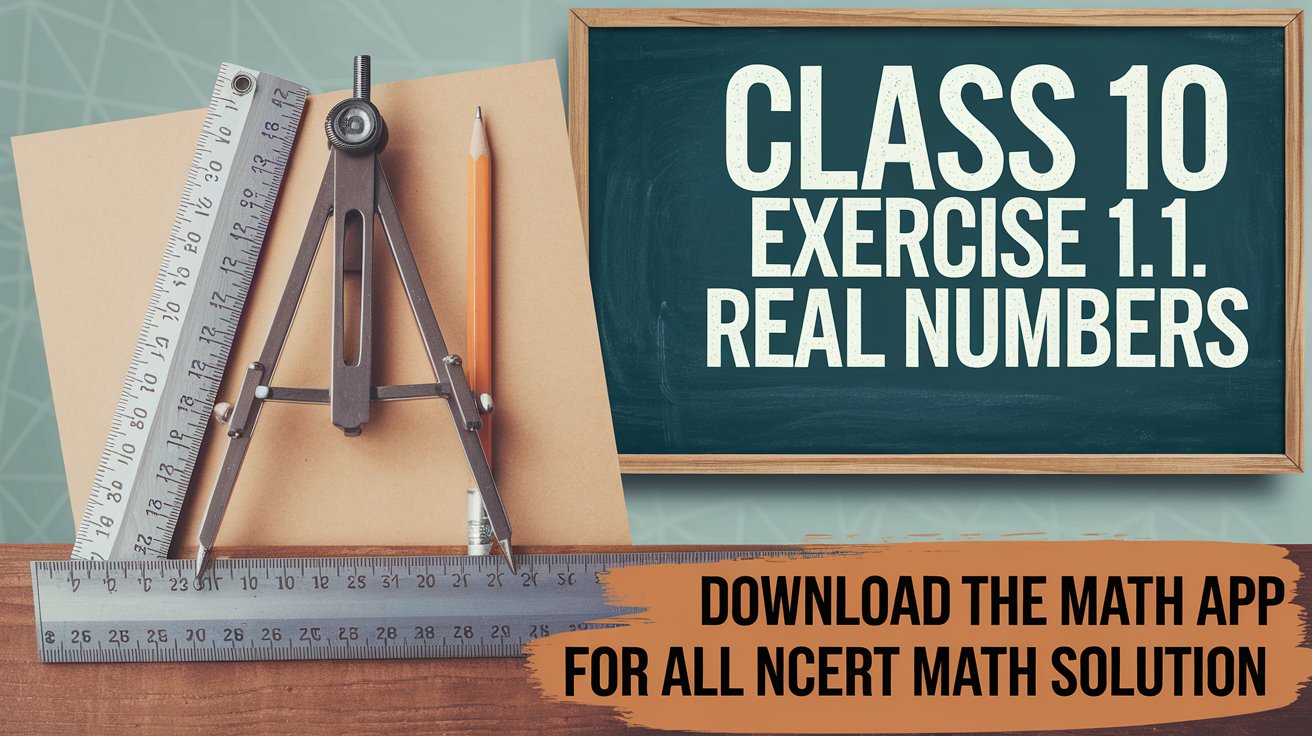NCERT Solutions for Class 10 Maths Chapter 1 Exercise 1.1 | CBSE class 10 maths chapter 1 Ex 1.1
Get the complete NCERT Solutions for Class 10 Maths Chapter 1: Real Numbers, covering Exercise 1.1. This free resource helps you understand key concepts and solve problems with ease, perfect for Class 10 students preparing for exams using NCERT Maths materials. We hope the NCERT Solutions for Class 10 Maths Chapter 1 Real Numbers Exercise 1.1 help you. If you have any queries regarding NCERT Maths Solutions Chapter 1 Real Numbers Exercise 1.1, drop a comment below, and we will get back to you at the earliest. || NCERT Class 10 Mathematics Chapter 1: Complete Resource for Real Numbers – For Free.

NCERT Solutions for Class 10 Maths Chapter 1 Exercise 1.1 | CBSE class 10 maths chapter 1 Ex 1.1
Exercise- 1.1
NCERT Solutions for Class 10 Maths Chapter 1 Exercise 1.1 | CBSE class 10 maths chapter 1 Ex 1.1
Download the Math Ninja App Now1
(i) Use Euclid's division algorithm to find the HCF of:
135 and 225
135 and 225
Answer
To obtain the HCF of two positive integers, say c and d, with \( \mathrm{c} > \mathrm{d} \), we follow the steps below:Step 1 : Apply Euclid's division lemma, to c and d. So, we find whole numbers, q and r such that \( \mathrm{c}=\mathrm{dq}+\mathrm{r}, 0 \leq \mathrm{r} < \mathrm{d} \).
Step 2 : If \( r=0 \), \( d \) is the HCF of \( c \) and \( d \). If \( r \neq 0 \), apply the division lemma to d and r.
Step 3 : Continue the process till the remainder is zero. The divisor at this stage will be the required HCF.
We know that,
\(=225 > 135\)
Applying Euclid's division algorithm:
(Dividend \( = \) Divisor \( \times \) Quotient \(+\) Remainder)
\(225=135 \times 1+90\)
Here remainder \( =90 \),
So, Again Applying Euclid's division algorithm
\(135=90 \times 1+45\)
Here remainder \( =45 \),
So, Again Applying Euclid's division algorithm
\( 90=45 \times 2+0 \)
Remainder \( =0 \),
Hence, \( \operatorname{HCF} \) of \( (135,225)=45 \)
(ii) Use Euclid's division algorithm to find the HCF of:
196 and 38220
196 and 38220
Answer
To obtain the HCF of two positive integers, say c and d, with \( \mathrm{c} > \mathrm{d} \), we follow the steps below:Step 1 : Apply Euclid's division lemma, to c and d. So, we find whole numbers, q and r such that \( \mathrm{c}=\mathrm{dq}+\mathrm{r}, 0 \leq \mathrm{r} < \mathrm{d} \).
Step 2 : If \( r=0 \), \( d \) is the HCF of \( c \) and \( d \). If \( r \neq 0 \), apply the division lemma to d and r.
Step 3 : Continue the process till the remainder is zero. The divisor at this stage will be the required HCF.
We know that,
\(38220 > 196\)
So, Applying Euclid's division algorithm
\( 38220=196 \times 195+0 \) (Dividend \( = \) Divisor \( \times \) Quotient \(+\) Remainder)
Remainder \( =0 \)
Hence, \( \operatorname{HCF} \) of \( (196,38220)=196 \)
(iii) Use Euclid's division algorithm to find the HCF of:
867 and 255
867 and 255
Answer
To obtain the HCF of two positive integers, say c and d, with \( \mathrm{c} > \mathrm{d} \), we follow the steps below:Step 1 : Apply Euclid's division lemma, to c and d. So, we find whole numbers, q and r such that \( \mathrm{c}=\mathrm{dq}+\mathrm{r}, 0 \leq \mathrm{r} < \mathrm{d} \).
Step 2 : If \( r=0 \), \( d \) is the HCF of \( c \) and \( d \). If \( r \neq 0 \), apply the division lemma to d and r.
Step 3 : Continue the process till the remainder is zero. The divisor at this stage will be the required HCF.
We know that,
\(867 > 255\)
So, Applying Euclid's division algorithm
\( 867=255 \times 3+102 \) (Dividend \( = \) Divisor \( \times \) Quotient \(+\) Remainder)
Remainder \( =102 \)
So, Again Applying Euclid's division algorithm
\(255=102 \times 2+51\)
Remainder \( =51 \)
So, Again Applying Euclid's division algorithm
\(102=51 \times 2+0\)
Remainder \( =0 \)
Hence,
\( (\mathrm{HCF} \text{ Of } 867 \) and \(255 )=51 \)
NCERT Solutions for Class 10 Maths Chapter 1 Exercise 1.1 | CBSE class 10 maths chapter 1 Ex 1.1
Download the Math Ninja App Now
2. Show that any positive odd integer is of the form \( 6 q+1 \), or \( 6 q+ 3 \), or \( 6 \mathrm{q}+5 \), where q is some integer.
Answer
To Prove: Any Positive odd integer is of the form \( 6q + 1, 6q + 3, 6q +5\)Proof: To prove the statement by Euclid's lemma we have to consider divisor as 6 and then find out the possible remainders when divided by 6 By taking, '\( a \)' as any positive integer and \( b=6 \).
Applying Euclid's algorithm
\(
a=6 q+r
\)
As divisor is 6 the remainder can take only 6 values from 0 to 5
Here, \( r= \) remainder \( =0,1,2,3,4,5 \) and \( q \geq 0 \)
So, total possible forms are \( 6 q+0,6 q+1,6 q+2,6 q+3,6 q+4 \) and \( 6 q+5 \)
\( 6 q+0, \) (6 is divisible by 2, its an even number)
\( 6 \mathrm{q}+1 \), (6 is divisible by 2 but 1 is not divisible by 2, its an odd number)
\( 6 \mathrm{q}+2 \), (6 and 2 both are divisible by 2, its an even number)
\( 6 \mathrm{q}+3 \), (6 is divisible by 2 but 3 is not divisible by 2, its an odd number)
\( 6 \mathrm{q}+4 \), (6 and 4 both are divisible by 2, its an even number)
\( 6 \mathrm{q}+5 \), (6 is divisible by 2 but 5 is not divisible by 2, its an odd number)
Therefore, odd numbers will be in the form \( 6 q+1 \), or \( 6 q+3 \), or \( 6 q+5 \) Hence, Proved.
3. An army contingent of 616 members is to march behind an army band of 32 members in a parade. The two groups are to march in the same number of columns. What is the maximum number of columns in which they can march?
Answer
Suppose, both groups are arranged in 'n' columns, for completely filling each column,The maximum no of columns in which they can march is the highest common factor of their number of members. i.e. \( \mathrm{n}=\operatorname{HCF}(616,32) \)
By using, Euclid's division algorithm
\( 616=32 \times 19+8 \)
Remainder \( \neq 0 \)
So, again Applying Euclid's division algorithm
\( 32=8 \times 4+0 \)
HCF of \( (616,32) \) is 8.
So, They can march in 8 columns each.
4. Use Euclid's division lemma to show that the square of any positive integer is either of the form 3m or \( 3 \mathrm{m}+1 \) for some integer m.
Answer
To Prove: Square of any number is of the form 3 m or \( 3 \mathrm{~m}+1 \)Proof: to prove this statement from Euclid's division lemma, take any number as a divisor, in question we have 3 m and \( 3 \mathrm{~m}+1 \) as the form
So, By taking, '\( a \)' as any positive integer and \( b=3 \).
Applying Euclid's algorithm \( \mathrm{a}=\mathrm{bq}+\mathrm{r} \).
\(
a=3 q+r
\)
Here, \( \mathrm{r}= \) remainder \( =0,1,2 \) and \( \mathrm{q} \geq 0 \) as the divisor is 3 there can be only 3 remainders, 0, 1 and 2.
So, putting all the possible values of the remainder in, \( a=3 q+r \)
\( \mathrm{a}=3 \mathrm{q} \) or \( 3 \mathrm{q}+1 \) or \( 3 \mathrm{q}+2 \)
And now squaring all the values,
When \( a=3 q \) Squaring both sides we get,
\(a^{2}=(3 q)^{2}\)
\(a^{2}=9 q^{2}\)
\(a^{2}=3\left(3 q^{2}\right)\)
\(a^{2}=3 k_{1}\)
Where \( \mathrm{k}_{1}=3 \mathrm{q}^{2} \)
When \( \mathrm{a}=3 \mathrm{q}+1 \) Squaring both sides we get, \( \mathrm{a}^{2}=(3 \mathrm{q}+1)^{2} \)
\(a^{2}=9 q^{2}+6 q+1\)
\(a^{2}=3\left(3 q^{2}+2 q\right)+1\)
\(a^{2}=3 k^{2}+1\)
Where \( \mathrm{k}_{2}=3 \mathrm{q}^{2}+2 \mathrm{q} \)
When \( \mathrm{a}=3 \mathrm{q}+2 \)
Squaring both sides we get, \( \mathrm{a}^{2}=(3 \mathrm{q}+2)^{2} \)
\(
\begin{array}{l}
\mathrm{a}^{2}=9 \mathrm{q}^{2}+12 q+4 \\
\mathrm{a}^{2}=9 \mathrm{q}^{2}+12 q+3+1 \\
\mathrm{a}^{2}=3\left(3 \mathrm{q}^{2}+4 q+1\right)+1 \\
\mathrm{a}^{2}=3 \mathrm{k}_{3}+1
\end{array}
\)
Where \( k_{3}=3 q^{2}+4 q+1 \)
Where \( \mathrm{k}_{1}, \mathrm{k}_{2} \) and \( \mathrm{k}_{3} \) are some positive integers
Hence, it can be said that the square of any positive integer is either of the form 3 m or \( 3 \mathrm{~m}+1 \).
5. Use Euclid's division lemma to show that the cube of any positive integer is of the form \( 9 m, 9 m+1 \) or \( 9 m+8 \).
Answer
Let a be any positive integer. Then, it is of the form 3q or, \( 3 q+1 \) or, \( 3 q+2 \). We know that according to Euclid's division lemma:
\( \mathrm{a}=\mathrm{bq}+\mathrm{r} \) So, we have the following cases:
Case I When \( \mathrm{a}=3 \mathrm{q} \)
In this case, we have
\( a^{3}=(3 q)^{3}=27 q^{3}=9\left(3 q^{3}\right)=9 m \), where \( m=3 q 3 \)
Case II When \( \mathrm{a}=3 \mathrm{q}+1 \)
In this case, we have
\(
\begin{array}{l}
a^{3}=(3 q+1)^{3} \\
\Rightarrow 27 q^{3}+27 q^{2}+9 q+1 \\
\Rightarrow 9 q\left(3 q^{2}+3 q+1\right)+1 \\
\Rightarrow a^{3}=9 m+1, \text { where } m=q\left(3 q^{2}+3 q+1\right)
\end{array}
\)
Case III When \( \mathrm{a}=3 \mathrm{q}+2 \)
In this case, we have
\(
\begin{array}{l}
a^{3}=(3 q+1)^{3} \\
\Rightarrow 27 q^{3}+54 q^{2}+36 q+8 \\
\Rightarrow 9 q\left(3 q^{2}+6 q+4\right)+8 \\
\Rightarrow a^{3}=9 m+8, \text { where } m=q\left(3 q^{2}+6 q+4\right)
\end{array}
\)
Hence, \( a^{3} \) is the form of \( 9 m \) or, \( 9 m+1 \) or, \( 9 m+8 \)
NCERT Solutions for Class 10 Maths Chapter 1 Exercise 1.1 | CBSE class 10 maths chapter 1 Ex 1.1
Download the Math Ninja App Now
Central Board of Secondary Education Official Site
Class 10 : NCERT Solutions for Class 10 Maths Chapter 1 Exercise 1.2
Class 10 : CBSE Class 10 Maths Chapter 2 Polynomials Ex 2.1 || NCERT Solutions for Class 10 Maths Chapter 2: Polynomials (English Medium)
Class 10 : CBSE Class 10 Maths Chapter 10 Circles solutions Ex 10.2
Class 10 : CBSE Class 10 Maths Chapter 13 Surface Areas and Volumes solutions Ex 13.3
Class 10 : NCERT Solutions for Class 10 Maths Chapter 1 Exercise 1.2
Class 10 : CBSE Class 10 Maths Chapter 2 Polynomials Ex 2.1 || NCERT Solutions for Class 10 Maths Chapter 2: Polynomials (English Medium)
Class 10 : CBSE Class 10 Maths Chapter 10 Circles solutions Ex 10.2
Class 10 : CBSE Class 10 Maths Chapter 13 Surface Areas and Volumes solutions Ex 13.3
